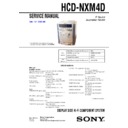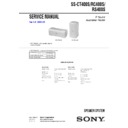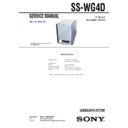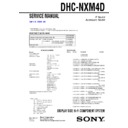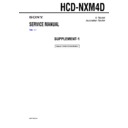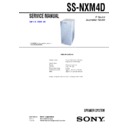Read Sony DHC-NXM4D / HCD-NXM4D Service Manual online
HCD-NXM4D
E Model
Australian Model
SERVICE MANUAL
DISPLAY SIDE Hi-Fi COMPONENT SYSTEM
Sony Corporation
Audio Group
Published by Sony Engineering Corporation
Published by Sony Engineering Corporation
9-877-971-03
2005E02-1
© 2005.05
© 2005.05
SPECIFICATIONS
Ver. 1.2 2005.05
– Continued on next page –
• HCD-NXM4D is the Amplifier, DVD player,
tape deck and tuner section in DHC-NXM4D.
Model Name Using Similar Mechanism
NEW
DVD
DVD Mechanism Type
CDM81A-DVBU60
Section
Base Unit Name
DVBU60
Optical Pick-up Name
DBU-3
TAPE
Model Name Using Similar Mechanism
HCD-CPX22
Section
Main unit
Amplifier section
The following measured at AC 120, 127, 220, 240 V, 50/60 Hz
DIN power output (rated):
Amplifier section
The following measured at AC 120, 127, 220, 240 V, 50/60 Hz
DIN power output (rated):
60 + 60 watts
(6 ohms at 1 kHz, DIN)
(6 ohms at 1 kHz, DIN)
Continuous RMS power output (reference)
Front speaker:
Front speaker:
75 + 75 watts
(6 ohms at 1 kHz, 10% THD)
(6 ohms at 1 kHz, 10% THD)
Center speaker:
40 watts (6 ohms at 1 kHz, 10% THD)
Surround speaker:
40 + 40 watts
(6 ohms at 1 kHz, 10% THD)
(6 ohms at 1 kHz, 10% THD)
Sub woofer:
120 watts
(4 ohms at 100 Hz, 10% THD)
(4 ohms at 100 Hz, 10% THD)
Inputs
VIDEO/SAT IN (phono jacks):
VIDEO/SAT IN (phono jacks):
voltage 250/450 mV, impedance 47
kilohms
kilohms
MIC1/MIC2 (phone jacks):
sensitivity 1 mV, impedance 10
kilohms
kilohms
Outputs
VIDEO/SAT OUT (phono jacks):
VIDEO/SAT OUT (phono jacks):
voltage 250 mV, impedance 1 kilohm
VIDEO OUT (phono jack):
max. output level
1 Vp-p, unbalanced, Sync negative,
load impedance 75 ohms
1 Vp-p, unbalanced, Sync negative,
load impedance 75 ohms
S VIDEO OUT (4-pin/mini-DIN jack):
Y: 1 Vp-p, unbalanced,
Sync negative, C: 0.286 Vp-p, load
impedance 75 ohms
Sync negative, C: 0.286 Vp-p, load
impedance 75 ohms
COMPONENT VIDEO OUT:
Y: 1 Vp-p, 75 ohms
PB, PR: 0.7 Vp-p, 75 ohms
PB, PR: 0.7 Vp-p, 75 ohms
PHONES (stereo mini jack): accepts headphones of 8 ohms or
more
FRONT SPEAKER:
Use only the supplied speaker
SS-NXM4D
SS-NXM4D
SURROUND SPEAKER:
Use only the supplied speaker
SS-RS400S
SS-RS400S
CENTER SPEAKER :
Use only the supplied speaker
SS-CT400S
SS-CT400S
SUB WOOFER SPEAKER: Use only the supplied speaker
SS-WG4D
2
HCD-NXM4D
Notes on chip component replacement
• Never reuse a disconnected chip component.
• Notice that the minus side of a tantalum capacitor may be
• Notice that the minus side of a tantalum capacitor may be
damaged by heat.
Flexible Circuit Board Repairing
• Keep the temperature of soldering iron around 270˚C
during repairing.
• Do not touch the soldering iron on the same conductor of the
circuit board (within 3 times).
• Be careful not to apply force on the conductor when soldering
or unsoldering.
CAUTION
Use of controls or adjustments or performance of procedures
other than those specified herein may result in hazardous
radiation exposure.
Use of controls or adjustments or performance of procedures
other than those specified herein may result in hazardous
radiation exposure.
This appliance is classified as
a CLASS 1 LASER product.
This label is located on the rear
exterior.
a CLASS 1 LASER product.
This label is located on the rear
exterior.
SAFETY-RELATED COMPONENT WARNING!!
COMPONENTS IDENTIFIED BY MARK 0 OR DOTTED LINE WITH
MARK 0 ON THE SCHEMATIC DIAGRAMS AND IN THE PARTS
LIST ARE CRITICAL TO SAFE OPERATION. REPLACE THESE
COMPONENTS WITH SONY PARTS WHOSE PART NUMBERS
APPEAR AS SHOWN IN THIS MANUAL OR IN SUPPLEMENTS
PUBLISHED BY SONY.
MARK 0 ON THE SCHEMATIC DIAGRAMS AND IN THE PARTS
LIST ARE CRITICAL TO SAFE OPERATION. REPLACE THESE
COMPONENTS WITH SONY PARTS WHOSE PART NUMBERS
APPEAR AS SHOWN IN THIS MANUAL OR IN SUPPLEMENTS
PUBLISHED BY SONY.
Disc player section
System
System
Compact disc and digital audio and
video system
video system
Laser
Semiconductor laser
(DVD:
(DVD:
λ=650 nm, CD: λ=780 nm)
Emission duration: continuous
Frequency response
DVD (PCM 48 kHz):
2 Hz – 22 kHz (
2 Hz – 22 kHz (
±1 dB)
CD: 2 Hz – 20 kHz (
±1 dB)
Video color system format
Latin American model: NTSC
Other models: NTSC, PAL
Other models: NTSC, PAL
Tape deck section
Recording system
Recording system
4-track 2-channel stereo
Frequency response
50 – 13,000 Hz (
±3 dB), using Sony
TYPE I cassette
Tuner section
FM stereo, FM/AM superheterodyne tuner
FM tuner section
Tuning range
FM stereo, FM/AM superheterodyne tuner
FM tuner section
Tuning range
87.5 – 108.0 MHz (50 kHz step)
Antenna
FM lead antenna
Antenna terminals
75 ohms unbalanced
Intermediate frequency
10.7 MHz
AM tuner section
Tuning range
Latin American models:
Tuning range
Latin American models:
530 – 1,710 kHz
(with the interval set at 10 kHz)
531 – 1,710 kHz
(with the interval set at 9 kHz)
(with the interval set at 10 kHz)
531 – 1,710 kHz
(with the interval set at 9 kHz)
Saudi Arabian models:
531– 1,602 kHz
(with the interval set at 9 kHz)
(with the interval set at 9 kHz)
Other models:
531 – 1,602 kHz
(with the interval set at 9 kHz)
530 – 1,710 kHz
(with the interval set at 10 kHz)
(with the interval set at 9 kHz)
530 – 1,710 kHz
(with the interval set at 10 kHz)
Antenna
AM loop antenna
Antenna terminals
External antenna terminal
Intermediate frequency
450 kHz
General
Power requirements
Australian model:
Power requirements
Australian model:
230 – 240 V AC, 50/60 Hz
Saudi Arabian model:
120 – 127 V or 220 – 240 V AC,
50/60 Hz
Adjustable with voltage selector
50/60 Hz
Adjustable with voltage selector
Thai model:
220 V AC, 50/60 Hz
Other models:
120 V or 220 – 240 V AC, 50/60 Hz
Adjustable with voltage selector
Adjustable with voltage selector
Power consumption
315 watts
Dimensions (w/h/d)
Approx. 230 x 290 x 355 mm
Mass
Approx. 7.0 kg
Design and specifications are subject to change without notice.
3
HCD-NXM4D
TABLE OF CONTENTS
1.
SERVICING NOTES
................................................
4
2.
GENERAL
Location of Controls ........................................................
5
3.
DISASSEMBLY
3-1.
Disassembly Flow ...........................................................
7
3-2.
Case .................................................................................
8
3-3.
Back Panel .......................................................................
8
3-4.
DVD Section ...................................................................
9
3-5.
Main Board ...................................................................... 10
3-6.
Front Panel ...................................................................... 10
3-7.
Front Amp Boardm Sur Amp Board ................................ 11
3-8.
Tape Mechanism Deck .................................................... 12
3-9.
Panel Board ..................................................................... 12
3-10. Video Board ..................................................................... 13
3-11. DMB07 Board, DVD Mechanism Deck
3-11. DMB07 Board, DVD Mechanism Deck
(CDM81A-DVBU60) ...................................................... 13
3-12. Tray .................................................................................. 14
3-13. Motor Board, M761 (LD/ST Motor),
3-13. Motor Board, M761 (LD/ST Motor),
M762 (BU U/D Motor) ................................................... 14
3-14. Base Unit (DVBU60) ...................................................... 15
3-15. RF Board ......................................................................... 15
3-16. Optical Pick-Up (DBU-3) ............................................... 16
3-15. RF Board ......................................................................... 15
3-16. Optical Pick-Up (DBU-3) ............................................... 16
4.
TEST MODE
.............................................................. 17
5.
MECHANICAL ADJUSTMENTS
....................... 19
6.
ELECTRICAL ADJUSTMENTS
Deck section .................................................................... 26
Video Section .................................................................. 27
Video Section .................................................................. 27
7.
DIAGRAMS
7-1.
Circuit Board Location .................................................... 29
7-2.
Block Diagram – DVD DSP (1/2) Section – .................. 31
7-3.
Block Diagram – DVD DSP (2/2) Section – .................. 32
7-4.
Block Diagram – Tuner/Tape Deck Section – ................ 33
7-5.
Block Diagram – Main Section – ................................... 34
7-6.
Block Diagram – Amp Section – .................................... 35
7-7.
Printed Wiring Board – RF Board – ............................... 36
7-8.
Schematic Diagram – RF Board – .................................. 37
7-9.
Printed Wiring Board – DVD Mechanism Board – ....... 38
7-10. Schematic Diagram – DVD Mechanism Board – .......... 39
7-11. Printed Wiring Board – DMB07 Board (Side A) – ........ 40
7-12. Printed Wiring Board – DMB07 Board (Side B) – ........ 41
7-13. Schematic Diagram – DMB07 Board (1/6) – ................. 42
7-14. Schematic Diagram – DMB07 Board (2/6) – ................. 43
7-15. Schematic Diagram – DMB07 Board (3/6) – ................. 44
7-16. Schematic Diagram – DMB07 Board (4/6) – ................. 45
7-17. Schematic Diagram – DMB07 Board (5/6) – ................. 46
7-18. Schematic Diagram – DMB07 Board (6/6) – ................. 47
7-19. Printed Wiring Board – Video Board – .......................... 48
7-20. Schematic Diagram – Video Board – ............................. 49
7-21. Printed Wiring Boards – Main Board – .......................... 50
7-22. Schematic Diagram – Main Board (1/3) – ..................... 51
7-23. Schematic Diagram – Main Board (2/3) – ..................... 52
7-24. Schematic Diagram – Main Board (3/3) – ..................... 53
7-25. Printed Wiring Boards – Panel Board – ......................... 54
7-26. Schematic Diagram – Panel Board – ............................... 55
7-27. Printed Wiring Board – Disc SW, Vol, HP Board – ....... 56
7-28. Schematic Diagram – Disc SW, Vol, HP Board – .......... 57
7-29. Printed Wiring Board – Front Amp Board – .................. 58
7-30. Schematic Diagram – Front Amp Board – ..................... 59
7-31. Printed Wiring Board – SURAmp Board – .................... 60
7-32. Schematic Diagram – SUR Amp Board – ...................... 61
7-33. IC Block Diagram ........................................................... 63
7-11. Printed Wiring Board – DMB07 Board (Side A) – ........ 40
7-12. Printed Wiring Board – DMB07 Board (Side B) – ........ 41
7-13. Schematic Diagram – DMB07 Board (1/6) – ................. 42
7-14. Schematic Diagram – DMB07 Board (2/6) – ................. 43
7-15. Schematic Diagram – DMB07 Board (3/6) – ................. 44
7-16. Schematic Diagram – DMB07 Board (4/6) – ................. 45
7-17. Schematic Diagram – DMB07 Board (5/6) – ................. 46
7-18. Schematic Diagram – DMB07 Board (6/6) – ................. 47
7-19. Printed Wiring Board – Video Board – .......................... 48
7-20. Schematic Diagram – Video Board – ............................. 49
7-21. Printed Wiring Boards – Main Board – .......................... 50
7-22. Schematic Diagram – Main Board (1/3) – ..................... 51
7-23. Schematic Diagram – Main Board (2/3) – ..................... 52
7-24. Schematic Diagram – Main Board (3/3) – ..................... 53
7-25. Printed Wiring Boards – Panel Board – ......................... 54
7-26. Schematic Diagram – Panel Board – ............................... 55
7-27. Printed Wiring Board – Disc SW, Vol, HP Board – ....... 56
7-28. Schematic Diagram – Disc SW, Vol, HP Board – .......... 57
7-29. Printed Wiring Board – Front Amp Board – .................. 58
7-30. Schematic Diagram – Front Amp Board – ..................... 59
7-31. Printed Wiring Board – SURAmp Board – .................... 60
7-32. Schematic Diagram – SUR Amp Board – ...................... 61
7-33. IC Block Diagram ........................................................... 63
8.
EXPLODED VIEWS
8-1.
Case, Rear Panel Section ................................................. 78
8-2.
Front Panel Section ......................................................... 79
8-3.
Chassis Section ................................................................ 80
8-4.
DVD Mechanism Deck Section-1
(CDM81A-DVBU60) ..................................................... 81
8-5. DVD Mechanism Deck Section-2
(CDM81A-DVBU60) ..................................................... 82
8-6. DVD Mechanism Deck Section-3
(CDM81A-DVBU60) ..................................................... 83
8-7.
Base Unit (DVBU60) ...................................................... 84
9.
ELECTRICAL PARTS LIST
................................ 85
4
HCD-NXM4D
SECTION 1
SERVICING NOTES
NOTES ON HANDLING THE OPTICAL PICK-UP BLOCK
OR BASE UNIT
OR BASE UNIT
The laser diode in the optical pick-up block may suffer electrostatic
break-down because of the potential difference generated by the
charged electrostatic load, etc. on clothing and the human body.
During repair, pay attention to electrostatic break-down and also
use the procedure in the printed matter which is included in the
repair parts.
The flexible board is easily damaged and should be handled with
care.
break-down because of the potential difference generated by the
charged electrostatic load, etc. on clothing and the human body.
During repair, pay attention to electrostatic break-down and also
use the procedure in the printed matter which is included in the
repair parts.
The flexible board is easily damaged and should be handled with
care.
NOTES ON LASER DIODE EMISSION CHECK
The laser beam on this model is concentrated so as to be focused on
the disc reflective surface by the objective lens in the optical pick-
up block. Therefore, when checking the laser diode emission, observe
from more than 30 cm away from the objective lens.
the disc reflective surface by the objective lens in the optical pick-
up block. Therefore, when checking the laser diode emission, observe
from more than 30 cm away from the objective lens.
LASER DIODE AND FOCUS SEARCH OPERATION CHECK
Carry out the “S curve check” in “CD section adjustment” and check
that the S curve waveform is output several times.
that the S curve waveform is output several times.
• SERVICE POSITION FOR TAPE MECHANISM DECK
tape mechanism deck
Jig (J-2501-271-A)
Jig (J-2501-270-A)
CN301
CN302
• NOTE ON CD/DVD MECHANISM DECK EXCHANGE
If CD/DVD mechanism deck is exchanged while the desk had gone into trays 2 or 3, since the address is memorized by the microprocessor,
the set will not operate normally.
In this case, please perform cold reset with reference to test mode (page 17.)
the set will not operate normally.
In this case, please perform cold reset with reference to test mode (page 17.)
• Abbreviation
E2
: 120 V AC Area in E model
E3
: 240 V AC Area in E model
E15 : Iran model
EA
EA
: Saudi Arabia model
SP
: Singapore model
MY : Malaysia model
AUS : Australian model
TH
AUS : Australian model
TH
: Thai model
• MODEL IDENTIFICATION
– Back Panel –
– Back Panel –
MODEL
PART No.
SP, MY models
4-253-361-0[]
E2 model
4-253-361-1[]
E3, E15 model
4-253-361-2[]
EA model
4-253-361-3[]
AUS model
4-253-361-4[]
TH model
4-253-361-5[]
PART No.

